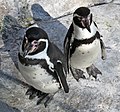Humboldt penguin: Difference between revisions
No edit summary |
No edit summary |
||
| Line 19: | Line 19: | ||
The '''Humboldt Penguin''' (''Spheniscus humboldti'') (aka Peruvian Penguin, or '''Patranca''') is a South American penguin, breeding in coastal Peru and Chile. Its nearest relatives are the African Penguin, the Magellanic Penguin and the Galápagos Penguin. The penguin is named after Alexander von Humboldt, a naturalist and explorer who first described the animal to the scientific community. |
The '''Humboldt Penguin''' (''Spheniscus humboldti'') (aka Peruvian Penguin, or '''Patranca''') is a South American penguin, breeding in coastal Peru and Chile. Its nearest relatives are the African Penguin, the Magellanic Penguin and the Galápagos Penguin. The penguin is named after Alexander von Humboldt, a naturalist and explorer who first described the animal to the scientific community. |
||
Humboldt Penguins are medium-sized penguins, growing to 65-70 cm (26-28 in) long and a weight of 3.6-5.9 kg (8-13 lbs).<ref>http://www2.philadelphiazoo.org/zoo/Meet-Our-Animals/Birds/Penguins/Humboldt-Penguin.htm</ref> They have a black head with a white border running from behind the eye, around the black ear-coverts and |
Humboldt Penguins are medium-sized penguins, growing to 65-70 cm (26-28 in) long and a weight of 3.6-5.9 kg (8-13 lbs).<ref>http://www2.philadelphiazoo.org/zoo/Meet-Our-Animals/Birds/Penguins/Humboldt-Penguin.htm</ref> They have a black head with a white border running from behind the eye, around the black ear-coverts and chin, to join on the throat. They have blackish-grey upperparts and whitish underparts, with a black breast-band extending down the flanks to the thigh. They have a fleshy-pink base to the bill. Juveniles have dark heads and no breast-band. |
||
Humboldt Penguins nest on |
Humboldt Penguins nest on islands and rocky coasts, burrowing holes in guano and sometimes using scrapes or caves. |
||
The current status of this penguin is |
The current status of this penguin is vulnerable, due to a declining population caused in part by over-fishing. Historically it was the victim of guano over-exploitation. Penguins are also declining in numbers due to habitat destruction. The current population is estimated at between 3,300 and 12,000. |
||
==Gallery== |
==Gallery== |
||
Revision as of 12:20, 9 October 2008
| Humboldt Penguin | |
|---|---|

| |
| Kölner Zoo, Cologne, Germany. | |
| Scientific classification | |
| Kingdom: | |
| Phylum: | |
| Class: | |
| Order: | |
| Family: | |
| Genus: | |
| Species: | S. humboldti
|
| Binomial name | |
| Spheniscus humboldti Meyen, 1834
| |
The Humboldt Penguin (Spheniscus humboldti) (aka Peruvian Penguin, or Patranca) is a South American penguin, breeding in coastal Peru and Chile. Its nearest relatives are the African Penguin, the Magellanic Penguin and the Galápagos Penguin. The penguin is named after Alexander von Humboldt, a naturalist and explorer who first described the animal to the scientific community.
Humboldt Penguins are medium-sized penguins, growing to 65-70 cm (26-28 in) long and a weight of 3.6-5.9 kg (8-13 lbs).[1] They have a black head with a white border running from behind the eye, around the black ear-coverts and chin, to join on the throat. They have blackish-grey upperparts and whitish underparts, with a black breast-band extending down the flanks to the thigh. They have a fleshy-pink base to the bill. Juveniles have dark heads and no breast-band.
Humboldt Penguins nest on islands and rocky coasts, burrowing holes in guano and sometimes using scrapes or caves.
The current status of this penguin is vulnerable, due to a declining population caused in part by over-fishing. Historically it was the victim of guano over-exploitation. Penguins are also declining in numbers due to habitat destruction. The current population is estimated at between 3,300 and 12,000.
Gallery
-
Upper body
-
With eggs
-
St Louis Zoo
-
A pair of Humboldt Penguins kissing at Cotswold Wildlife Park
-
Swimming underwater
-
Back
References
- Template:IUCN2006 Database entry includes justification for why this species is vulnerable






